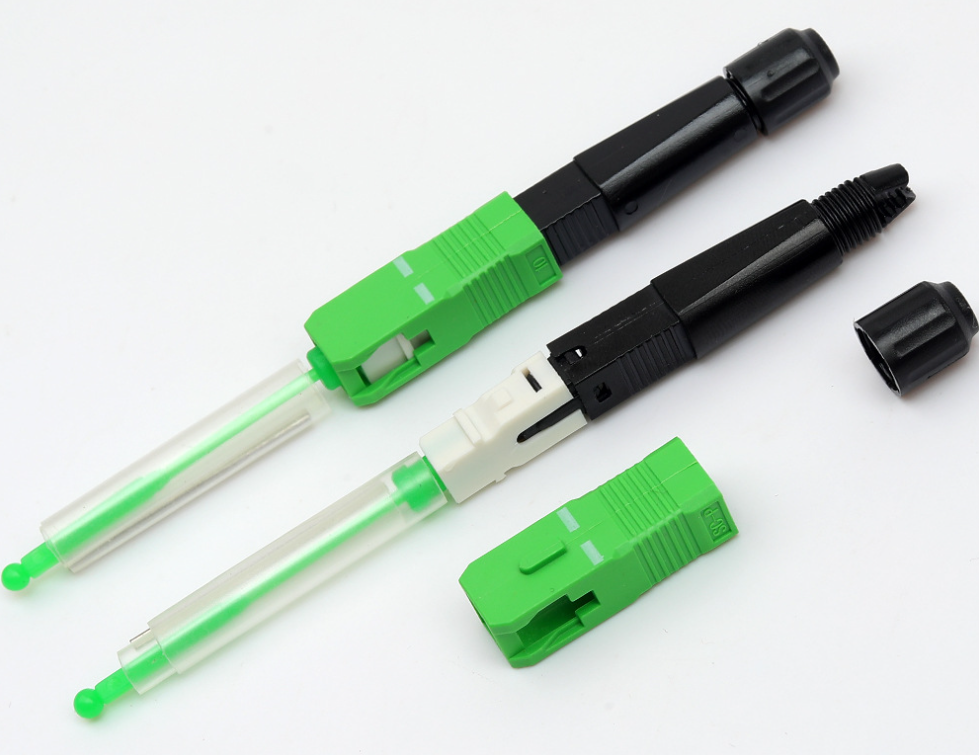The Advantages of SC APC Hot Melt Splice Connector for Fiber Optic Quick Connection

Discovering the World of Fiber Optic Quick Connections
The Basics of Fiber Optic Technology
Fiber optic technology revolutionized the way data is transmitted, offering unparalleled advantages over traditional copper wiring. What Makes Fiber Optic Different? Unlike copper wires, fiber optics use light to carry data, allowing for faster transmission speeds and greater bandwidth. This makes them ideal for high-speed internet, telecommunication networks, and cable television systems. The Role of Connectors in Fiber Optics is crucial as they facilitate the seamless connection of optical fibers, ensuring efficient data transmission.
Why Quick Connectors Matter
In today's fast-paced digital landscape, Speed and Efficiency in Modern Networks are paramount. Quick connectors play a pivotal role in expediting installation processes and minimizing network downtime. As technology continues to advance, The Evolution of Quick Connection Solutions has led to the development of innovative quick connectors that offer enhanced performance and reliability.
The Revolutionary Hot Melt Splice Connector
In the realm of fiber optic technology, the hot melt splice connector has emerged as a game-changing innovation, revolutionizing the way optical fibers are connected. Understanding Hot Melt Splice Connector Technology unveils a cutting-edge method that simplifies and accelerates the installation process, ensuring optimal performance. The Science Behind the Hot Melt Method involves utilizing a precisely controlled heating element to fuse optical fibers together seamlessly, eliminating the need for adhesives or curing ovens. This advanced technique not only enhances efficiency but also guarantees a reliable and durable connection.
When Comparing Hot Melt to Traditional Methods, it becomes evident that traditional connectors often require time-consuming processes such as polishing and adhesive curing. In contrast, hot melt splice connectors offer a swift and straightforward approach, significantly reducing installation time and labor costs. The elimination of messy adhesives and complex curing procedures sets hot melt connectors apart as a superior choice for modern fiber optic networks.
Key Features of SC APC Hot Melt Splice Connectors
The SC APC hot melt splice connectors boast an array of features that position them at the forefront of fiber optic connectivity solutions. Low Insertion Loss and High Return Loss are pivotal attributes that ensure minimal signal attenuation and maximum signal reflection back into the light source. This results in seamless data transmission with minimal disruptions or loss of quality. Furthermore, their Ease of Use and Installation makes them exceptionally user-friendly, allowing for quick termination of single-mode and multimode fibers without the need for specialized tools or extensive training.
Swift fusion process
Minimal signal attenuation
Maximum signal reflection
Practical Benefits of Using Hot Melt Splice Connectors
As we delve into the practical benefits of utilizing hot melt splice connectors in fiber optic networks, it becomes evident that they contribute significantly to network performance and cost-effectiveness. Let's explore how these innovative connectors enhance connectivity solutions.
Enhanced Network Performance
The integration of hot melt splice connectors has a profound impact on data transmission speed, ensuring swift and seamless delivery of information across fiber optic networks. By minimizing signal attenuation and maximizing signal reflection, these connectors play a crucial role in maintaining high-speed data transmission, meeting the demands of modern digital communication.
Moreover, their reliability in long-haul networks is unparalleled. Whether spanning extensive geographical areas or connecting various network nodes, hot melt splice connectors provide consistent and dependable connectivity. This reliability is essential for applications requiring continuous data transmission over long distances, such as telecommunications infrastructure and internet backbone networks.
Cost-Effectiveness and Time Savings
One of the primary advantages of hot melt splice connectors lies in their cost-effectiveness and time-saving attributes. By reducing the need for special tools, these connectors streamline the installation process, eliminating the requirement for complex and expensive equipment. This not only reduces initial investment costs but also simplifies maintenance and repairs, contributing to long-term cost savings.
Furthermore, hot melt splice connectors minimize installation time significantly. Unlike traditional methods that involve intricate polishing and adhesive curing procedures, hot melt technology offers a swift fusion process that expedites installation without compromising quality. This efficiency translates to reduced labor costs and operational downtime, making it an ideal choice for businesses seeking agile network deployment solutions.
Real-World Applications and Success Stories
As we delve into the real-world applications of hot melt splice connectors, it's essential to examine their impact across various industries and gain insights from successful implementations. Let's explore how these innovative connectors have transformed connectivity solutions and contributed to success stories in the field.
Case Studies: Success in the Field
Telecommunications Industry
The telecommunications industry relies heavily on robust and reliable connectivity solutions to ensure seamless data transmission across vast networks. Hot melt splice connectors have emerged as a game-changing technology, offering unparalleled performance and durability in telecommunications infrastructure. By minimizing signal attenuation and maximizing signal reflection, these connectors play a pivotal role in maintaining high-speed data transmission, meeting the demands of modern digital communication. Their swift fusion process and user-friendly installation make them an ideal choice for telecommunications companies seeking agile network deployment solutions.
Data Centers and IT Infrastructure
In the realm of data centers and IT infrastructure, where connectivity is paramount, hot melt splice connectors have garnered significant attention for their practical benefits. The integration of these connectors has led to enhanced network performance, ensuring swift and seamless delivery of information across fiber optic networks within data centers. Moreover, their reliability in long-haul networks is invaluable for connecting various network nodes within IT infrastructure, providing consistent and dependable connectivity essential for continuous data transmission over long distances.
Personal Experience with SC APC Connectors
Challenges Overcome
In my experience with hot melt splice connectors, I encountered various challenges that underscored the importance of reliable connectivity solutions. Traditional methods often posed time-consuming processes such as polishing and adhesive curing, leading to operational downtime and increased labor costs. However, upon integrating hot melt technology, these challenges were effectively overcome. The swift fusion process not only expedited installation but also minimized disruptions, ensuring seamless connectivity without compromising quality.
Achievements and Learnings
Through my journey with hot melt splice connectors, I've witnessed firsthand the transformative impact they have on network performance and cost-effectiveness. The successful implementation of these connectors has not only streamlined installation processes but also contributed to long-term cost savings through reduced labor costs and operational downtime. This experience has reinforced the significance of leveraging innovative technologies such as hot melt splice connectors to drive efficiency and reliability in fiber optic networks.
Wrapping Up
The Future of Fiber Optic Connections
Innovations in fiber optic technology continue to shape the landscape of digital connectivity, paving the way for Fiber Optic Quick Connectors to evolve and meet the growing demands of modern networks. As we look ahead, it's evident that advancements in connector design, installation methods, and performance optimization will drive the future of fiber optic connections. Innovations on the Horizon are expected to focus on enhancing the speed and efficiency of quick connectors while ensuring seamless compatibility with evolving network architectures.
Moreover, the integration of advanced materials and manufacturing techniques is poised to elevate the durability and reliability of Fiber Optic Quick Connectors, making them indispensable components in high-speed data transmission networks. These innovations aim to address the increasing need for rapid deployment solutions without compromising on performance or longevity.
Why SC APC Hot Melt Splice Connectors Are Here to Stay
Amidst these advancements, SC APC Hot Melt Splice Connectors are positioned as enduring solutions in the realm of fiber optic connectivity. Their proven track record of delivering low insertion loss, high return loss, and swift fusion processes solidifies their relevance in modern networks. As network infrastructures continue to expand and evolve, these connectors offer a steadfast foundation for seamless data transmission across diverse applications.
The user-friendly installation process and cost-effective attributes further reinforce the longevity of SC APC hot melt splice connectors in meeting the ever-growing demands for efficient fiber optic connections. With their practical benefits and reliable performance, these connectors are poised to remain integral components in shaping the future of fiber optic connectivity.
Final Thoughts
In conclusion, exploring the world of Fiber Optic Quick Connectors unveils a realm of innovation and efficiency that continues to redefine digital connectivity. The transformative impact of hot melt splice connectors underscores their pivotal role in enhancing network performance while streamlining installation processes. My Takeaways from this exploration emphasize the significance of leveraging advanced technologies such as hot melt splice connectors to drive efficiency and reliability in fiber optic networks.
As I conclude this journey through the realm of fiber optic quick connections, I extend my Encouragement for Future Users to embrace these innovative solutions as they navigate the dynamic landscape of digital connectivity. By harnessing cutting-edge technologies like SC APC hot melt splice connectors, businesses can propel their networks into a future defined by speed, reliability, and seamless data transmission.
See Also
Exploring the Advantages of FastConnect Fiber Field Assembly Connector
Discovering the Advantages of 960 Core Fiber Optical Splice Closure
Attaining Superior Performance and Affordable Fiber Optic Connectivity
Advantages of Water-resistant Fiber Optic Cables: OptiTap MPO Multimode OM3 IP68-rated
Sturdy and Dependable 2 in 1 Harden Optical Connector Cable Assemblies


